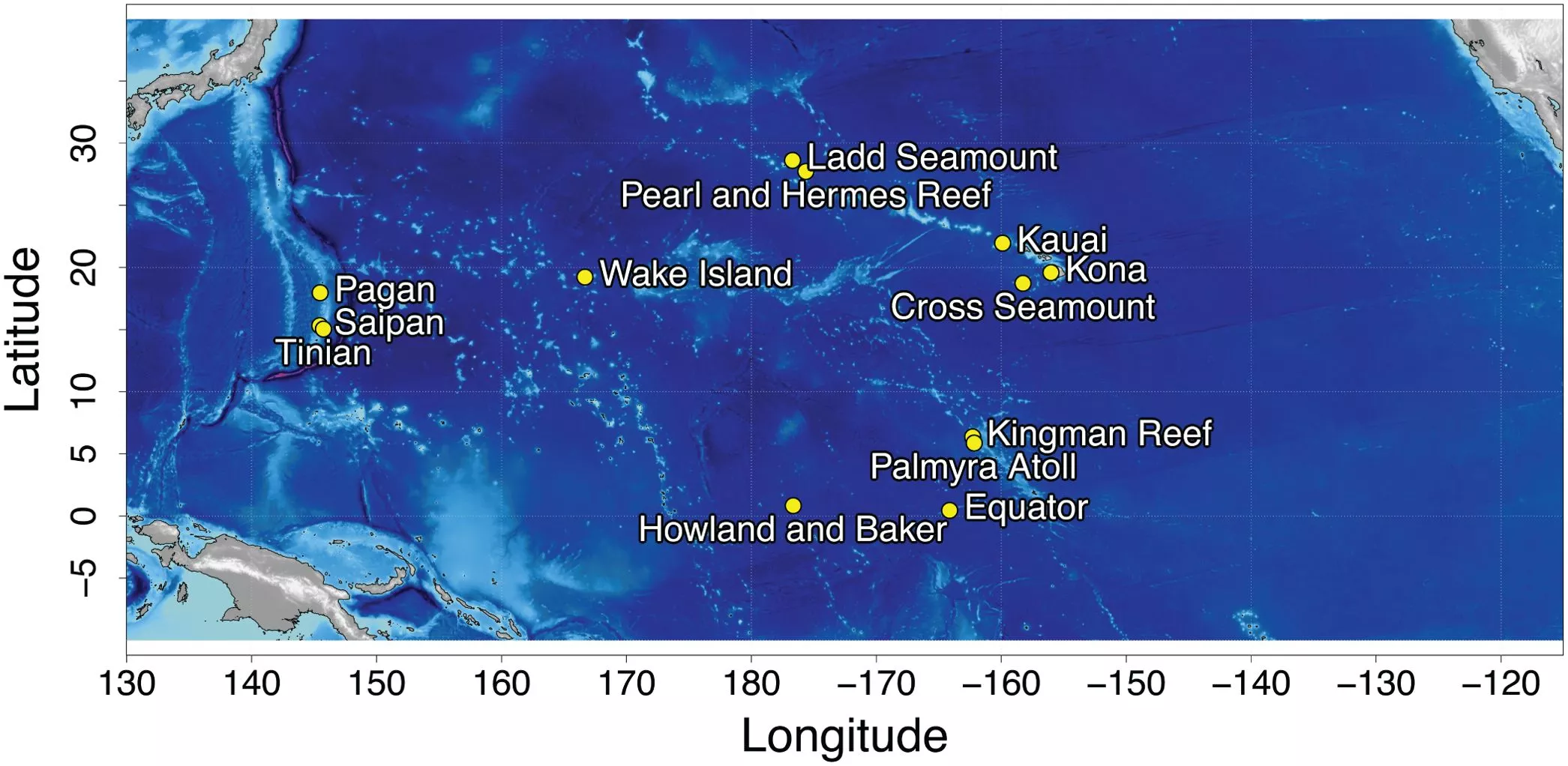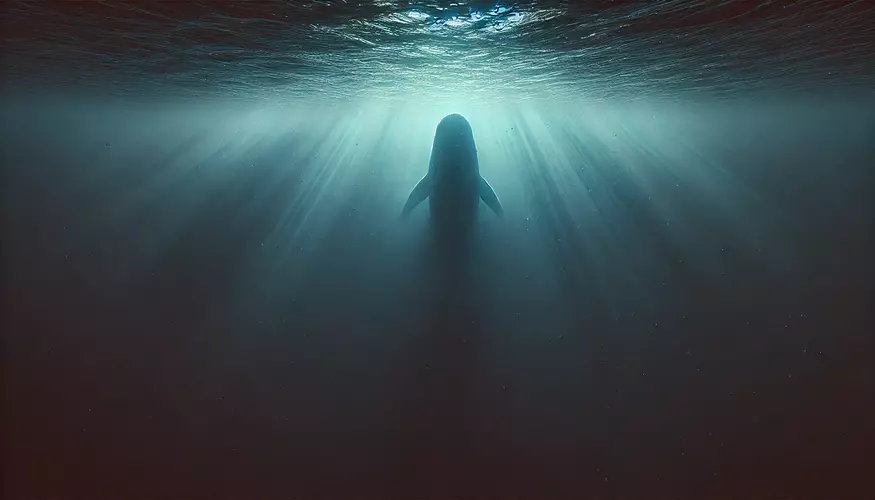After a decade of mystery, scientists have finally solved the enigma surrounding strange sounds echoing from the depths of the Pacific Ocean, dubbed “Biotwang.”
In a new study published in Frontiers in Marine Science, researchers confirmed previous speculation that Bryde’s whales are responsible for the bizarre noises.
The breakthrough was made possible by advanced artificial intelligence (AI) tools, which analyzed thousands of hours of oceanic audio recordings, filtering through the vast array of underwater sounds to identify the distinctive whale calls.
Researchers also introduced an AI-powered app capable of tracking these elusive whales, marking a major leap forward in marine biology and conservation.
The journey to solving this oceanic mystery began in 2014 when autonomous acoustic recordings from the Mariana Archipelago picked up the unusual Biotwang sounds.
The complex call, lasting about 3.5 seconds, consisted of five distinct parts, beginning with a deep, 30 Hz growl and ending with a metallic resonance that reached up to 8,000 Hz. The sound, with its low rumble followed by a high-pitched ringing, resembled something more out of a sci-fi movie than what you’d expect to hear in the ocean.
“I think it actually sounds like the original ‘ping’ on the Starship Enterprise from Star Trek,” study co-author and Google data scientist Lauren Harrell told Popular Science.
A study published by researchers from Oregon State University in 2016 suggested that the strange, low-frequency hums heard across the Pacific were most likely produced by Bryde’s whales, based on preliminary acoustic analyses. However, there was insufficient data to confirm the theory at the time, and the exact source of the sounds remained uncertain.
Yet, recent breakthroughs in acoustic monitoring and machine learning have finally allowed researchers to confirm that Bryde’s whales are responsible for the mysterious “Biotwang” sounds.
Bryde’s whales (pronounced “broodus”) are a species of baleen whale found primarily in tropical and subtropical oceans around the world. They are medium-sized compared to other whales, typically reaching lengths of up to 40-50 feet and weighing around 15-28 tons.
Unlike more well-known whale species like the humpback or blue whale, Bryde’s whales are elusive and solitary. They often prefer deeper, offshore waters, which makes them difficult to study. They feed on small fish, plankton, and crustaceans by using baleen plates to filter their food from the water.
Named after Norwegian shipowner Johan Bryde, who helped set up the first whaling stations in South Africa, these whales are known for their speed and agility, as well as their vocalizations, which have long puzzled scientists due to their low frequency and the remote areas in which they occur.
Researchers were finally able to confirm that the “Biotwangs” were coming from Bryde’s whales during a survey around the Mariana Islands. While observing several of these elusive whales, the team lowered underwater microphones and recorded the mysterious Biotwang sounds at the same time as nine additional Bryde’s whale sightings.
This direct correlation between the whale sightings and the acoustic recordings provided definitive evidence that Bryde’s whales were indeed the source of the strange sounds.
With the identification of the Biotwang call, researchers turned to technology to enhance their ability to monitor Bryde’s whales. Partnering with engineers at Google, scientists developed an AI-powered app capable of analyzing vast amounts of acoustic data. By using machine learning algorithms, the app can detect the unique Biotwang sounds from hours of recordings, enabling researchers to track the whales as they journey through the ocean depths.
The AI app scans through historical and live acoustic data, identifying where the whales are currently and providing insights into their seasonal movements. This has revealed that the Bryde’s whales producing Biotwangs migrate between low and mid-latitudes, with peaks in their calls occurring between February and April and again between August and November.
“Our results provide evidence for a pelagic WNP [Western North Pacific] population of Bryde’s whales with broad distribution, but with seasonal and inter-annual variation in occurrence that imply a complex range most likely linked to changing oceanographic conditions in this region,” researchers wrote.


The identification of Bryde’s whales as the source of the Biotwang calls has profound implications for conservation efforts. Due to their fragmented populations, Bryde’s whales are considered vulnerable, and understanding their migration and behavior is essential for their protection.
The AI app offers an unprecedented opportunity to gather detailed data on the species’ movements. With this technology, researchers can monitor how changing ocean conditions, such as warming seas and shifting prey distribution, impact the whales’ migration routes. This information is crucial as climate change continues to alter marine ecosystems.
According to the U.S. National Oceanic and Atmospheric Administration (NOAA), the biggest threats to Bryde’s whale populations are vessel strikes, ocean noise, and commercial whaling, especially on the coasts of Indonesia and the Philippines.
The ability to track Bryde’s whales also has broader implications for marine conservation. This new AI tool, applying similar methods, could be used to study other cryptic species. This could lead to more effective marine protected areas and better-informed policy decisions that could help preserve marine biodiversity.
The successful identification of the once-mysterious Biotwangs highlights how cutting-edge technology, such as artificial intelligence, is being integrated with traditional fields like marine biology to drive new breakthroughs.
For the first time, researchers now clearly understand where the elusive Bryde’s whales are traveling and can monitor their movements in near real-time. This newfound ability will be crucial for informing future conservation efforts.
Understanding how species like Bryde’s whales are affected by ocean change will be key to ensuring their survival. With the help of AI, scientists are better equipped than ever to protect these enigmatic creatures and the ecosystems they inhabit.
Despite the breakthrough in identifying Bryde’s whales as the source of the bizarre Biotwang sounds, the reason behind these unique vocalizations remains a mystery.
Scientists are still unsure whether the calls serve as a form of communication, a mating signal, or perhaps even a way for the whales to navigate their deep-water environments. Further research is needed to fully understand the purpose and meaning of these enigmatic sounds, leaving much to discover about these elusive creatures.
“It’s possible that they use the Biotwang as a contact call, a sort of ‘Marco Polo’ of the ocean,” study co-author and NOAA research oceanographer Ann Allen suggested. “But we need more information before we can say for sure.”
Nevertheless, “Having a model that can at least go through these long-term data sets efficiently and identify and classify where some of these species are likely present, that can then also break that down by time and frequency can really unlock our ability to study these species,” fellow co-author, Harrell, added.
Tim McMillan is a retired law enforcement executive, investigative reporter and co-founder of The Debrief. His writing typically focuses on defense, national security, the Intelligence Community and topics related to psychology. You can follow Tim on Twitter: @LtTimMcMillan. Tim can be reached by email: tim@thedebrief.org or through encrypted email: LtTimMcMillan@protonmail.com

